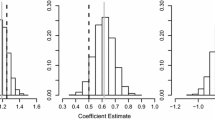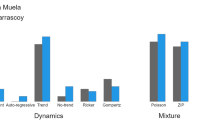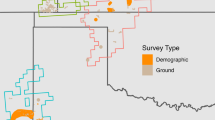Abstract
This study illustrates the use of modern statistical procedures for better wildlife management by addressing three key issues: determination of abundance, modeling of animal distributions and variability of diversity in space and time. Prior information in Markov Chain Monte Carlo (MCMC) methods is used to improve estimates of abundance. Measures of autocorrelation are included when modeling distributions of animal counts, and a diversity index to indicate species abundance and richness for large herbivores is developed. Data from the Masai Mara ecosystem in Kenya are used to develop and demonstrate these procedures. The new abundance estimates are up to 35% more accurate than those obtained by existing methods. Significant temporal changes in spatial patterns are found from a space-time analysis of elephant counts over a 20-year period, with strong interactions over 5 km and 6 months space and time separations, respectively. The new diversity index is sensitive to both high abundance and species richness and is also able to capture year to year variation. It indicates an overall marginal decrease in diversity for large herbivores in the Mara ecosystem. The space-time analyses and diversity index can easily be computed thereby providing tools for rapid decision making.
Similar content being viewed by others
References
Agresti, A. (1990) Categorical Data Analysis, Wiley, New York.
Anselin, L. (1993) Discrete space autoregressive models. In Environmental Modeling with GIS, M.F. Goodchild, B.O. Parks, and L.T. Steyaert (eds), Oxford University Press, New York pp. 454-69.
Augustin, N.H., Mugglestone, M.A., and Buckland, S.T. (1996) An autologistic model for the spatial distribution of wildlife. Journal of Applied Ecology, 33, 339-47.
Berzuini, C. (1996) Medical monitoring. In Markov Chain Monte Carlo in Practice, W.R. Gilks, S. Richardson, and D.J. Spiegelhalter (eds), Chapman & Hall, London. pp. 321-37.
Brooks, S.P. (1998) Markov Chain Monte Carlo method and its application. The Statistician, 47(1), 69-100.
Broten, M.D. and Said, M.Y. (1995) Population trends of ungulates in and around Kenya's Masai Mara reserve. In Serengeti II: Dynamics, Management and Conservation of an ecosystem, A.R.E. Sinclair and P. Arcese (eds), University of Chicago Press, Chicago, pp. 160-93.
Cressie, N.A.C. (1993) Statistics for Spatial Data, Wiley, New York.
De Leeuw, J., Prins, H.H.T., Njuguna, E.C., Said, M.Y., and de By, R.A. (1998) Interpretation of DRSRS animal counts (1977–1997) in the Rangeland Districts of Kenya. DRSRS, Nairobi/ITC, Enschede.
Gelman, A., Carlin, J.B., Stern, H.S., and Rubin, D.B. (1995) Bayesian Data Analysis, Chapman & Hall, London.
Geman, S. and Geman, D. (1984) Stochastic relaxation, Gibbs distributions and the Bayesian restoration of images. IEEE Trans. Pattn. Anal. Mach. Intel., 6, 721-41.
Gilks, W.R., Richardson, S., and Spiegelhalter, D.J. (1996) Introducing Markov Chain Monte Carlo. In Markov Chain Monte Carlo in Practice, W.R. Gilks, S. Richardson, and D.J. Spiegelhalter (eds), Chapman & Hall, London, pp. 1-19.
Green, P.J. (1996) MCMC in image analysis. In Markov Chain Monte Carlo in Practice, W.R. Gilks, S. Richardson, and D.J. Spiegelhalter (eds), Chapman & Hall, London, pp. 381-99.
Grunblatt, J., Said, M.Y., Wargute, P., and Kifugo, S.C. (1995) DRSRS aerial surveys database, DRSRS, Ministry of Planning and National Development, Nairobi.
Grunblatt, J., Said, M.Y., and Wargute, P. (1996) DRSRS National Rangelands Report. Summary of Population Estimates for Wildlife and Livestock. Kenyan Rangelands 1977–1996, DRSRS, Ministry of Planning and National Development, Nairobi.
Jolly, G.M. (1969) Sampling methods for aerial censuses of wildlife populations. East African Agricultural and Forestry Journal, 34, 46-9.
Khaemba, W.M. and Stein, A. (1999) An improved airborne survey sampling and estimation of parameters for African wildlife species. Biometrics, in press.
Li, W., Wang, Z., Ma, Z., and Tang, H. (1997) A regression model for the spatial distribution of redcrown crane in Yancheng biosphere reserve, China. Ecological modeling, 103, 115-21.
Magurran, A.E. (1988) Ecological Diversity and its Measurement, Croom Helm, London.
Norton-Griffiths, M. (1978) Counting Animals, Handbook 1, 2nd edn, African Wildlife Foundation, Nairobi.
Patil, G.P. and Taillie, C. (1979) An overview of diversity. In Ecological Diversity in Theory and Practice, J.F. Grassle, G.N. Patil, W. Smith, and C. Taillie (eds), International Co-operative Publishing House, Fairland, Maryland pp. 3-27.
Pereira, M.C.J. and Itami, R.M. (1991) GIS-based habitat modeling using logistic multiple regression: A study of the Grahan red squirrel. Journal of Photogrammetric Engineering and Remote Sensing, 51(11), 1475-86.
Rohl, F.J. and Sokal, R.R. (1995) Biometry, W.H. Freeman, New York.
Sinclair, A.R.E. (1995) Serengeti Past and Present. In Serengeti II: Dynamics, Management and Conservation of an Ecosystem, A.R.E. Sinclair and P. Arcese (eds), University of Chicago Press, Chicago. pp. 3-30.
Spiegelhalter, D.J., Best, N.G., Gilks, W.R., and Inskip, H. (1996) Hepatitis B: A case study in MCMC methods. In Markov Chain Monte Carlo in Practice, W.R. Gilks, S. Richardson, and D.J. Spiegelhalter (eds), Chapman & Hall, London, pp. 21-43.
Spielgelhalter, D.J., Thomas, A., Gilks, W.R., and Best, N.G. (1996) BUGS 0.5, Version ii, User Manual, Medical Research Council, Biostatistics Unit, Cambridge.
Stein, A. (1994) The use of prior information in spatial statistics. Geoderma, 62, 199-216.
Thompson, S.K. (1992) Sampling, John Wiley & Sons, New York.
Tukey, J.W. (1977) Exploratory Data Analysis, Addison-Wesley, Reading, MA.
Walker, P.A. (1990) Modeling wildlife distributions using a geographic information system: Kangaroos in relation to climate. Journal of Biogeography, 17, 279-89.
Wint, W. (1998) Rapid resource assessment and environmental monitoring using low level aerial surveys. In Drylands: Sustainable Use of Rangelands into the Twenty-first Century, V.R. Squires and A.E. Sidahmed (eds), IFAD publication, Rome, pp. 277-301.
Author information
Authors and Affiliations
Rights and permissions
About this article
Cite this article
Khaemba, W.M., Stein, A. Spatial statistics for modeling of abundance and distribution of wildlife species in the Masai Mara ecosystem, Kenya. Environmental and Ecological Statistics 8, 345–360 (2001). https://doi.org/10.1023/A:1012782402914
Issue Date:
DOI: https://doi.org/10.1023/A:1012782402914




